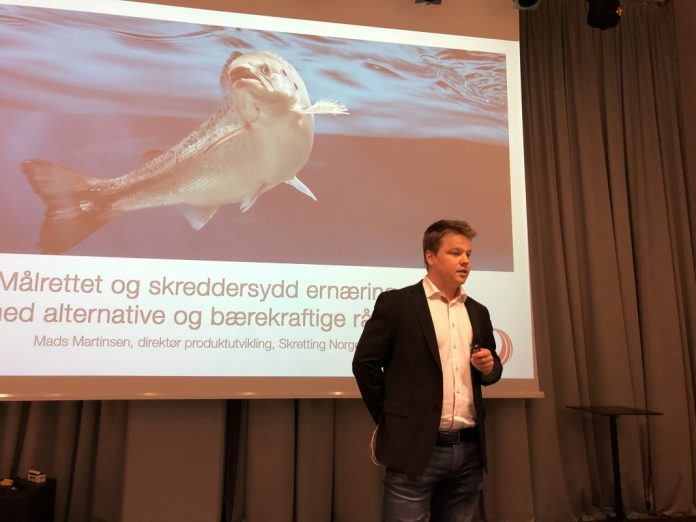Skretting’s Mads Martinsen believes the industry must invest in the new technology that is coming.
“We invest about EUR 21 million in innovation annually,” began Mads Martinsen, Skretting’s Product Development Manager.
The young biologist told SalmonBusiness that he has worked in Skretting for eight years.
“We are now starting to tailor feed to specific challenges. Against specific diseases, for individual sites. We have anti-lice feed although it is not a solution, but in combination with other measures,”
Distinguishing
Martinsen sees radical changes in the nutrition market.
“Being vegan was seen as something very strange a few years ago. It is no longer the case”.
He cites statistics that show that five-per-cent of today’s youth are vegans, over ten per-cent are vegetarians and over 20 per-cent are flexitarian.
“I’m a flexitarian. I’m conscious of the intake of meat. I substitute meat with seafood,” he added.
Stands for fall
He also pointed out that there is active work on fermentation and cell culture – and highlights the think tank RethinkX that advocates that these can outperform cows.
“It may not be a wonder that the cow stands for fall, because it is the least efficient producer of protein,” he says, pointing to the use of freshwater, land area and feed conversion.
“The salmon comes out well here. But we can’t rest on the laurels,” said Martinsen, adding: “This is a young industry. We have a lot to go on. But then we have to invest in the new technology that is coming – and that is disruptive”.
Option
“20 years ago, 30 per-cent of the feed was from so-called alternative raw materials. The fish was mainly fed on fishmeal and fish oil. Today, we are at about 80 per-cent of the feed from alternative raw materials. And that’s not a coincidence. We have been consciously working on that. We have the technology to not use marine raw materials at all.
“If the fishing industry collapses tomorrow, we have alternatives to produce the fish with as much EPA and DHA, he says, before quickly adding: “But it will be more expensive”.
The most important of these feed ingredients for farmed salmon is soy, primarily produced in Brazil. And just buying Brazilian soy has caught a lot of negative media attention in recent months.
“The industry will grow, but it will not grow on soy from Brazil. We will not buy more than we did in 2018,” he notes. “We are indirectly part of the problem,” he says, but points out that Skretting’s soy purchases are made exclusively from strictly certified farmers.
Novel
New feeding ingredients are the future of Skretting, as for the other feed suppliers. So-called “novel raw materials” will constitute six per-cent of Skretting’s raw material purchases in 2022.
And the raw materials of the future should have today’s criteria, he said, listing footprints, land area, CO2, freshwater and that it is not human food.
He first mentions insect feed. The wild salmon that roam the rivers eat a lot of insects.
“Insect larvae can live on waste from breweries and potato chip factories,” he said.
Other possibilities are harvesting new resources in the sea, such as harvesting of «new» resources in the ocean, like krill, and off-cuts from chicken. “We refrain from it, but we could. It would have made the feed much cheaper.”
“And then we have astronaut food. They breathe out CO2. By adding hydrogen one can cultivate protein bacteria. This is fermentation technology,” he said and hopes someone will pick up the gauntlet and build a 100,000-ton bacterial protein plant.

